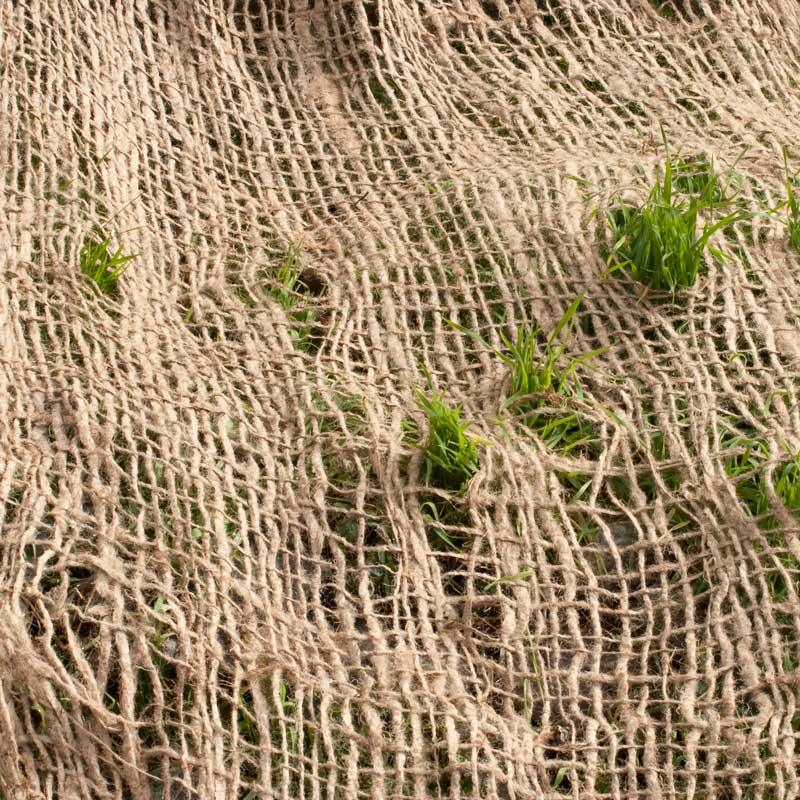- April 11, 2025
- Posted by: wellcoindustries
- Categories: Erosion Control, Jute Mesh
Growing grass from seed can be challenging, especially when environmental factors like erosion, wind, heavy rains, and birds threaten the seeds’ survival. Jute netting for grass seed to grow emerges as a practical, affordable, and eco-friendly solution to these problems. In this complete guide, we’ll explore how you can effectively use jute netting to ensure your grass seeds germinate quickly and thrive.

What Is Jute Netting and Why Is It Effective?
Jute netting is an open weave, biodegradable textile made from natural jute fibers. It’s specifically designed to protect and stabilize soil, providing a nurturing environment for grass seed germination. Here’s why it works:
-
Protection Against Erosion: The jute mesh holds soil in place, preventing erosion and runoff.
-
Moisture Retention: It helps retain moisture essential for seed germination.
-
Natural and Biodegradable: As grass grows, the jute netting naturally decomposes, enriching the soil.
According to studies, using natural erosion control materials like jute can reduce soil loss by up to 80%.
Step-by-Step Guide: Installing Jute Netting for Grass Seed
Step 1: Prepare the Ground
The first step for effective grass growth involves preparing your soil:
-
Remove debris, stones, and weeds.
-
Loosen compacted soil and level the ground using a rake.
-
If necessary, add compost or topsoil to enrich the area.
Step 2: Apply Grass Seeds
Once your soil is ready, proceed to plant your seeds:
-
Choose grass seed suitable for your climate and soil type.
-
Spread seeds evenly across the prepared area following the seed manufacturer’s recommended rate.
-
Gently rake the seeds into the topsoil to ensure good soil-seed contact.
Step 3: Lay the Jute Netting
The proper installation of the jute netting ensures it performs optimally:
-
Unroll the jute netting carefully across the seeded area.
-
Cut to size with scissors or a utility knife, ensuring slight overlap (approximately 4 inches) between sections.
-
Anchor the netting securely using biodegradable stakes or staples placed approximately every 3 feet along the edges and every 5–6 feet throughout the field.
Step 4: Water Thoroughly and Regularly
Proper moisture is critical for successful germination:
-
Immediately after installing the netting, water thoroughly to moisten the soil.
-
Continue watering regularly—daily or every other day—to keep the soil consistently moist but not waterlogged.
-
Adjust your watering routine based on weather conditions.
Common Mistakes to Avoid When Using Jute Netting
To maximize your lawn growth, avoid these common mistakes:
-
Improper Securing: Loose or inadequately secured netting can blow away, reducing effectiveness. Always secure netting with adequate biodegradable stakes.
-
Incorrect Seed Application: Uneven seeding leads to patchy grass growth. Always follow recommended seeding rates and distribution methods.
-
Neglecting Maintenance: Remember, jute netting isn’t maintenance-free. Regular watering and monitoring are essential for optimum growth.
Benefits of Using Jute Netting for Grass Growth
Understanding the advantages helps you see why jute netting is increasingly popular:
-
Faster Germination Rates: Seeds have ideal conditions to germinate quickly and uniformly.
-
Reduced Soil Erosion: Protecting soil from wind and water erosion preserves nutrients and seeds.
-
Eco-Friendly Option: Biodegradable and non-toxic, jute netting breaks down naturally, enhancing soil health.
-
Cost-Effective Solution: Inexpensive compared to alternative erosion control methods.
According to gardening experts, landscapes protected with biodegradable erosion control materials experience up to 25% faster vegetation establishment.
Frequently Asked Questions About Jute Netting
How Long Does Jute Netting Take to Decompose?
Typically, jute netting decomposes completely within 6 to 12 months, depending on local climate conditions and soil microorganisms.
Can Jute Netting Be Used on Slopes?
Yes, jute netting is particularly effective on slopes, where it significantly reduces runoff and erosion, providing stable conditions for grass seeds.
Does Jute Netting Need to Be Removed After Grass Grows?
No, one of its major advantages is that you don’t need to remove it; it naturally biodegrades into the soil.
Conclusion
Using jute netting for grass seed to grow can dramatically improve your lawn’s germination and establishment. By properly preparing your soil, carefully installing the netting, and maintaining consistent moisture, you’ll achieve a lush, healthy lawn in no time.
Ready to transform your lawn? Follow the steps provided and give jute netting a try. Have you had success using jute netting before, or are you planning to start soon? Let us know your experiences and questions in the comments below, and don’t forget to share this guide with others looking to improve their lawn growth!
